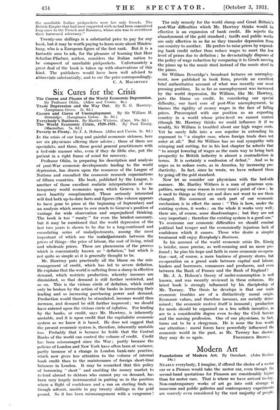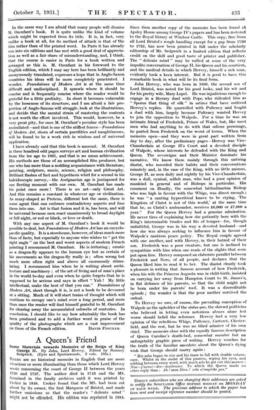Modern Art
NEARLY everybody, I imagine, if offered the choice of a motor car or a Picasso would take the motor car, even though the second-hand quotations for Picassos are considerably higher than for motor cars. That is where we have arrived to-day. Non-contemporary works of art go into cold storage in museums and public galleries and contemporary experiments are scarcely even considered by the vast majority of people•
In the same way I am afraid that many people will dismiss M. Ozenfant's book. It is quite unlike the kind of volume
which might be expected from its title. It is, in fact, very unlike a book at all, for its method of attack is that of the film rather than of the printed word. In Paris it has already run into six editions and has met with a good deal of apprecia- tion as well as a fair share of misunderstanding, and, I think,
that the course is easier in Paris for a book written and arranged as this is. M. Ozenfant in his foreword to the English edition, which I may say here has been brilliantly and anonymously translated, expresses a hope that in Anglo-Saxon countries his ideas will be more completely penetrated. I
wonder. Foundations of Modern Art is at the same time difficult and undisciplined. It sprawls where it should be concise and is frequently concise where the reader would be grateful for a little prolixity. In short it becomes vulnerable by the looseness of its structure, and I am afraid a fair pro- portion of Anglo-Saxons will struggle, look at the illustrations, and decide that the mental strain of mastering the contents is not worth the effort involved. This would, however, be a very great pity, for once M. Ozenfant's peculiar style has been assimilated—and that is one of the stiffest fences—Foundations of Modern Art, shorn of certain puerilities and naughtinesses, will be found to be a work rich in wisdom and of universal application.
I have already said that this book is unusual. M. Ozenfant in three hundred odd pages surveys art and human civilization from the ice age to 1931, and that is no mean achievement. His methods are those of an accomplished film producer, but one who has more than a nodding acquaintance with literature, painting, sculpture, music, science, religion and philosophy. Brilliant flashes of fact and hypothesis whirl for a second in his kaleidoscopic survey,—the Aurignacian age is juxtaposed for one fleeting moment with our own. M. Ozenfant has made his point once more ! There is no art—only Great Art. And this remains a constant in whatever age or civilization. As many-shaped as Proteus, different but the same, there is some agent that can embrace contradictory aspects and fuse them into one. Art is that fusion and it is, has been, and will be universal because men react unanimously to broad daylight or full night, or red or black, or love or death.
With any one aspect of M. Ozenfant's book it would be possible to deal, but Foundations of Modern Art has an encyclo- paedic quality. It is a storehouse, however, of ideas much more than of facts, but especially to anyone who wishes to " get the right angle " on the best and worst aspects of modern French painting I recommend M. Ozenfant. He is irritating ; erratic as a dragon-fly appears to the human eye but as certain of his movements as the dragon-fly really is ; often wrong but much more often right and above all enormously stimu- lating. I recommend him when he is writing about archi- tecture and machinery ; of the art of living and of man's place in the world to-day and even when he quite forgets that he is supposed to be serious and says in effect " Yah ! My little intellectual, make the best of that you can." Foundations of Modern Art, short though it is, is not a book to be devoured at a sitting. Much of it will start trains of thought which will continue to occupy one's mind over a long period, and more than once the reader will find himself grateful to M. Ozenfant for clearing away the accumulated cobwebs of centuries. In conclusion, I should like to say how admirably the book has been produced and to add a further word in praise of the quality of the photographs which are a vast improvement on those of the French edition. DAVID FJNCUAM.











































 Previous page
Previous page